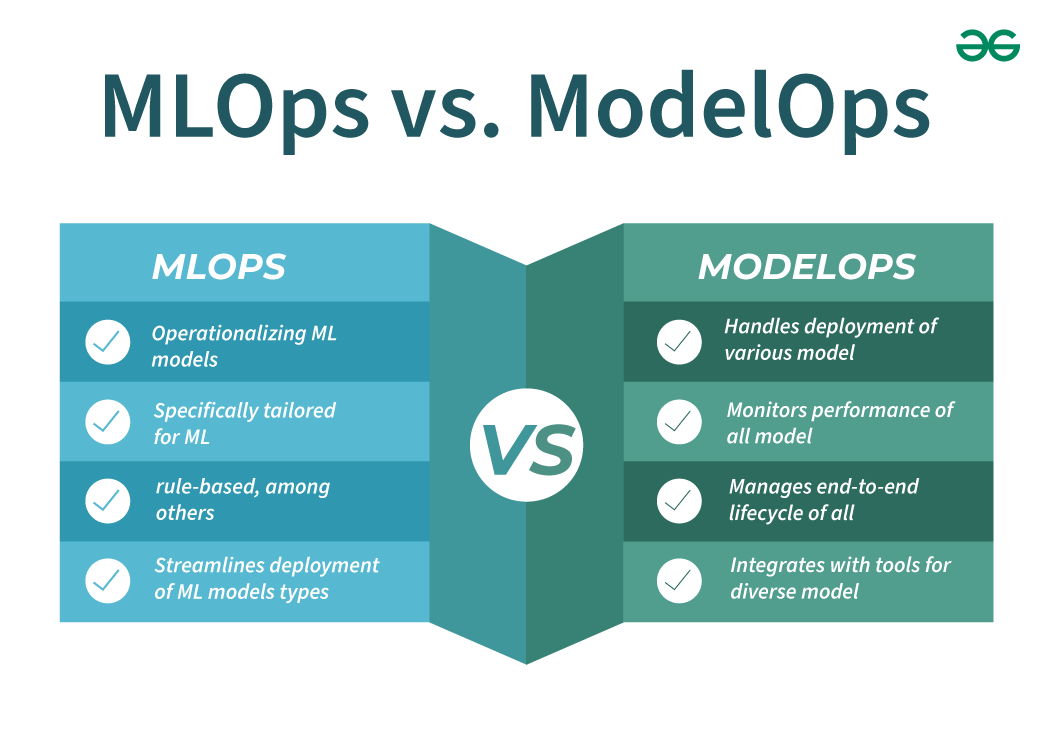MLOps vs. ModelOps
Last Updated :
18 Apr, 2024
The significance of machine learning operations (MLOps) and model operations for artificial intelligence (ModelOps) has grown as more businesses and organizations investigate machine learning applications. To optimize machine learning utilization and avoid costly pitfalls, enterprises should ideally invest in both MLOps and ModelOps.

MLOps Vs. ModelOps
What is MLOps?
MLOps is the set of practices and tools used to streamline and automate the deployment, monitoring, and management of machine learning models in production environments. It aims to bridge the gap between data science and operations to ensure that machine learning models are deployed and maintained effectively and efficiently.
Activities that are performed as part of ML Ops, following are some activities:
- Training and Re-training Models: This refers to teaching the AI model and keeping it up-to-date with new information.
- Connecting Models to Data Flow: Imagine a pipeline of data feeding the model, this step ensures a smooth connection.
- Sharing Models for Experimentation: Making these models available allows others to test and develop new ideas with them.
- Automating Model Development: This creates a system that can build and improve models without needing manual intervention every time.
- Monitoring and Replacing Models: Here, we track the model’s performance and swap it out with a better one when needed.
What is ModelOps?
ModelOps is a broader term encompassing the operationalization of various types of models beyond just machine learning models. It includes practices and tools for deploying, monitoring, and managing all types of models, such as statistical models, predictive models, and business rule-based models, in production environments. ModelOps focuses on the end-to-end lifecycle management of models, including versioning, testing, deployment, and monitoring, to ensure that models deliver value and remain effective over time.
Activities that are performed as part of ModelOps, following are some activities:
- Turning ML Workflows into Operations: Imagine a recipe for creating and using your AI model. ModelOps helps turn that recipe into a smooth, automated process.
- Automating AI Operations: Repetitive tasks involved in running AI models, like training and testing, are automated to save time and effort.
- Streamlining the Entire Pipeline: This includes automating everything from training the model (data pipeline) to managing different versions (version control), handling data, tracking experiments, testing the model’s performance, and finally deploying it for real-world use.
MLOps vs. ModelOps
| Aspect |
MLOps |
ModelOps |
| Focus |
Operationalizing ML models |
Operationalizing various models |
| Types of Models |
Specifically tailored for ML |
Covers statistical, predictive, and rule-based, among others |
| Deployment |
Streamlines deployment of ML models |
Handles deployment of various model types |
| Monitoring |
Monitors ML model performance |
Monitors performance of all model types |
| Lifecycle Management |
Manages end-to-end ML model lifecycle |
Manages end-to-end lifecycle of all model types |
| Tool Integration |
Integrates with ML-specific tools |
Integrates with tools for diverse model types |
| Collaboration |
Focuses on data science and operations collaboration |
Emphasizes collaboration across model development and deployment teams |
| Deployment Efficiency |
Ensures efficient ML model deployment |
Ensures efficient deployment for various model types |
Conclusion
ModelOps and MLOps are complimentary approaches. There is no rivalry between them. While Model Operations focuses on governance and the full life cycle management of AI and ML, it focuses on the development, assessment, and deployment of models. Organizations would require both AI and machine learning if they wished to use them. As a result, the company will grow faster and implement more models. While higher level organization personnel use it, data scientists and machine learning engineers do as well. The ML workflow process is automated, and the entire process is made operational. It offers reports, a dashboard, and other features.
Share your thoughts in the comments
Please Login to comment...